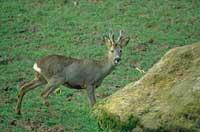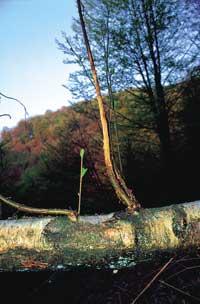Cutting management
Good management is essential for hunting to contribute to the conservation and development of all populations. And what is management? This is a set of actions aimed at increasing the attainable performance of a population, based on two axes for its suitability:
- Population dynamics: the hunting policy must be aimed at correcting the imbalances of the population structure.
- Medium load capacity. Admissible population control for each specific habitat.

Without a doubt, in order to manage it it is necessary to know what is there and know the state of the local roe deer population. To do this, you can use the information obtained during the smoothies, along with the information of the animal and remains observed on the mountain. On the other hand, it is advisable that the area to be managed is more than 500 hectares, since in smaller areas the own mobility of the animals prevents adequately knowing the size and structure of the population. In addition, to be able to say if there are many or few animals in the area that concerns us, we must compare our beliefs with the theoretical densities of roe deer. According to some studies, in an area of 100 hectares of deciduous and rich forest, there can be between 10 and 20 roe deer, but in a poor area of conifers of the same size, only 2-5 specimens.
As for the hunchable amount in a year, it should be noted that the population should not exceed the load capacity of the environment if no damage to the habitat is desired. It is necessary to try to keep the number of animals according to what the maximum production can give (usually less than what a certain habitat can have, since excessive density generates health problems). We must not forget that the habitat itself can be managed to improve its populations.

Among the recommended actions are the cleaning of fountains and wells or the maintenance of some bushes. In addition, in a stable population, the number of individuals hunted must be equivalent to population growth (25-30% in our case). When removing animals, in addition, the same number of males and females should be eliminated to avoid sexual imbalances. For someone this can be surprising, because females have no horns and are not considered trophies. But when only males are hunted, there are few males and many females left, which causes problems. It is also necessary to eliminate young people in order to maintain the proper structure of the population.
The objectives of the management are:
- Achieve the potential of the environment.
- Disseminate behaviors based on respect for the species.
- Reduce the influence of the hunter or furtivism in secret.
- Boost new hunting systems. Although it is normally hunted in smoothies, there are more suitable systems. The most suitable for achieving balanced populations is the spy, since the hunter and the guard leave together and hunt according to the planning: hunting the male, the female, the old, the young or any other.
Knowledge of sex and age

As mentioned in the previous lines, for proper management it is necessary to hunt certain specimens of this population. For this it is necessary to know how to differentiate between sex and age, so below are some basic indications:
The sexual dimorphism of this species is evident, except in the case of males who have horns on their heads, who are too small or who remain without horns. In the first case, the young roe deer have small horns from the 3rd month, so both sexes are distinguished to be able to observe them from there. As for the time when the males remain without horns, we can observe in the white spot of the northern part to differentiate the male from the female. The male has a white Renaissance back drawing and the female has a cardiac appearance, while the female has a white hair stroller at the bottom. In most cases, red-spot observation is a good system for getting to know sex.
In addition to these characteristics, it can also be detected if it is male or female, as in the form of the animal (with a stronger facade in the males), in the position it adopts when urinating, etc.
Depending on the age, the offspring born in that year can be easily separated until five months, since in addition to being small, they are dressed in leather with white spots. From there the branches of the males will help us to differentiate. At 11-13 months they have two wedges at the height of the ears. The following year, males can best have three-pronged branches that will peak at five years. The general aspect of the animal can help to know it so much, since young people are more slender and as they age they seem slower. Teething can also be seen with the animal in your hands.

Although not much was thought about hunting plans until a few years ago, today it is noted that control of all hunting activities is essential; in short, it will depend on the future of this elegant animal.
In Iparralde they have been managing ungulates for more years than in Hegoalde, and they have detected their consequences!





